
The Navy Department Library
GAf (German Air Force, Luftwaffe] and the Invasion of Normandy - 1944
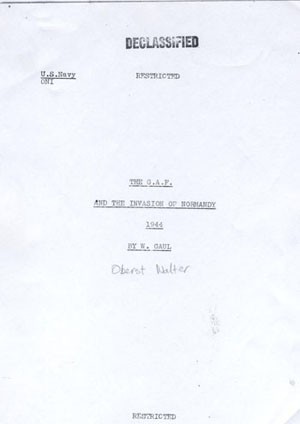
U.S. Navy
ONI
RESTRICTED
THE G.A.F.
[German Air Force, Luftwaffe]
AND THE INVASION OF NORMANDY
1944
by Oberst Walter Gaul
RESTRICTED
FOREWORD
The following work is a study of the part played by the G.A.F. (Luftflotte 3) in the invasion of Normandy from the beginning of April, 1944, until the allied breakthrough near Avranches on 1 August. It deals exclusively with the air force and merely refers to army operations in the field, where interpretation of the narrative demands.
CONTENTS
| CHAPTER I. The Situation before the Invasion | Para. | |
|---|---|---|
| Results of German air reconnaissance in April 1944 | 2 | |
| Conclusions | 3, 4, 5 | |
| Development of the Air Situation within the Reich. Effects on German Strategy against Great Britain | 6, 7/8 | |
| Conclusions | 9 | |
| CHAPTER II. The Invasion | Para. | |
| Signs of a contemplated landing | 11 | |
| The Allied Position from 6-13 June, 1944 | 12 | |
| CHAPTER III. Position of "Luftflotte 3" and the Calendar for June | Para. | |
| Organization and Strength of Luftflotte 3 | 13, 14 | |
| Conditions for Operations of Luftflotte 3 | 15, 16 | |
| Successes obtained in the first Week of June | 17 | |
| The Progress of Army Operations to the End of June | 18 | |
| Air Force Situation for Both Sides in the Second Half of June | 19, 20 | |
| Successes obtained by Luftflotte 3 in the Second Half of June | 21 | |
| The Balance after One Month | 22 | |
| CHAPTER IV. July 1944 | Para. | |
| Further Progress of Army Operations | 23 | |
| Operations of Luftflotte 3 | 24, 25 | |
| Changes in commitment of Luftflotte 3 | 26 | |
| Figures for and Losses sustained in Allied and German Air Force Operations | 27 | |
| Conclusion | 28 |
| Appendix 1 | Allied Shipping Losses during June | |
| Appendix 2 | Allied Shipping Losses during July | |
| * | Appendix 3-8 | Graphs of G.A.F. Operations and Losses |
| * | Appendix 9 | Allied Air Fields In the Invasion Area |
| * | Appendix 10 | The Position of the Army from 6 June to 1 August, 1944 |
* All based on German Sources.
SOURCE MATERIAL
| Supreme Command, G.A.F. | Chief of the General Staff, Air Force, 8th Division. Group VI. Invasion Calendar Normandy Vol. 2. |
| " " | Personal File "Group Ic" "Invasion". |
| " " | Chief of the General Staff, Air Force, "Course of the War", from 1 April to 30 June, 1944. Chief of the General Staff, Air Force, 8th Division. Criticism of the War (No. 15) Start of the Invasion. |
| War at Sea, Vol. V. |
EXPLANATORY NOTE ON G.A.F. ORGANIZATION
| Kotte | 3 | planes | |
| Staffel | 9-12 | planes | |
| Gruppe | 27-36 | planes | |
| Geschwader | 90-100 | planes. |
For operational purposes the above-mentioned units were grouped together as follows:
| Fliegerdivision | normally reconnaissance units and several bomber Geschwader (Total approximately 250 planes)*. |
| Fliegerkorps | normally reconnaissance units, fighter units (Gruppe or Geschwader) and bomber Geschwader. (Total varying approximately 300 to 600 planes.)* |
| Luftflotte | made up of several Korps. In addition to flying units each Luftflotte had maintenance units to supervise means of communication (radio, teleprinter, telephone, etc.) and was jointly responsible, together with the Luftgaukommandos within its area, for ground organization and supply. |
* Those figures denote the "establishment strength".
THE G.A.F. AND THE INVASION OF NORMANDY - 1944
CHAPTER I
At 0030 of 6 Jun, 1944, allied paratroops landed in the area between Seine and Orne. The invasion had begun.
This decisive operation on the part of the allies had been expected* A flood of agents' reports regarding the probable site chosen for the landing had kept the German High Command in suspense and had made necessary careful planning of possible counter-moves along the entire length of the coast from Norway to Southern France. The part played by German air reconnaissance in assessing the allied position was of major importance. A considerable amount of shipping would be involved in a large-scale invasion and must, of necessity, assemble at some point.
In April, 1944, the G.A.F. had gained an overall reconnaissance picture, partly with the aid of aerial photographs, of the ports and bases of the British Isles from Scotland to the Channel and the Thames. There was no evidence of any concentration of shipping on the east or west coasts of Scotland and therefore no confirmation of Axis agents' reports of possible landings in the Norwegian area. Nor did the Thames estuary, which was twice photographed from the air, show any signs of landing preparations. But the Portsmouth-Southampton sector made a very different picture. Here, at Spithead Reede, on 25 April, two hundred and sixty-four liberty ships, possibly tank transports, were observed by visual reconnaissance. A photograph of the two harbors showed a collection of landing craft and other vessels which unquestionably denoted preparations for invasion; it comprised two battleships, six cruisers, thirteen destroyers and escort vessels, three submarines, eleven minesweepers, three tank transports, five hundred and ten landing craft of all descriptions, fifteen transports of 128,000 G.R.T., fifteen steamers of 19,000 G.R.T. and two hundred and ninety small vessels. The Germans calculated that this amount of shipping could transport three divisions. The assembly of ships at Spithead Reede was a striking one, resembling the preparations for the raid on Dieppe in the summer of 1942. Thus from the activity centered around the Portsmouth/Southampton area, this appeared to be the probable starting-point of the invasion. The Plymouth/Brixham area, photographed from the air in the last week of April, showed landing craft capable of transporting 2½ divisions, which, together with two monitors, one battleship of the King George class and several large transports, might form a self-contained landing formation. On 27 April, in the Falmouth sector, ten tank transports and ninety landing craft were identified, enough for the possible, transport of one division.
--1--
Extensive landing preparations on the south coast of England, together with various emergency measures taken by the British government such as an embargo on shipping to Ireland, a veto on exit from England, etc., led to the conclusion that a full-scale allied landing might take place at any time from the Channel area. Moreover, the concentrated activity of the allied air force confirmed this impression. Railroads, coastal batteries and launching-sites for V-weapons between the Scheldt and the Seine had been feverishly bombarded since the beginning of April. It looked as though the opponent was trying to sever the coast from the terrain behind it. Railroad junctions in Belgium were heavily damaged and the effect on supplies was very serious. In April, 1944, for the first time, 5,900 aircraft made night attacks on occupied western territory compared with 5,500 sorties across Luftflotte 3 zone and the North Sea area into the Reich, showing that the focal point of allied night bombing had now switched to the west. Constant raids on German airfields near the coast not only depleted the air potential but so affected the ground organization as to make its operation difficult.
While the foregoing events focussed German attention on the Dunkirk-Dieppe sector and supported the theory held by both the Army High Command and the Supreme Command, Armed Forces, that the Allies would land in that area, there were, nevertheless, good reasons for accepting the Navy's view that the mouth of the Seine might prove to be the chosen spot. Absence of any allied effort to mine this part of the coast, good beaches and protection from westerly gales afforded by the Cotentin peninsula favored the latter theory. Conditions of tide, light and weather (high tide, full moon, good visibility and little wind) suggested the end of May as the most likely time for landing on the Channel coast.
But May came and went without invasion. In so far as allied air superiority allowed, German air reconnaissance confirmed the former picture of strong concentrations of shipping in the Channel area. The last satisfactory photographic report dates from 24 May and covers the harbors of Bournemouth, Poole, Portland, Weymouth, several river mouths and the coastal waters in this region. Folkestone and Dover were also photographed. Portland, Weymouth and Poole were particularly crowded with landing craft (L.S.I, loaded with L.C.P.) and all kinds of shipping. Twenty-five possible moles received special attention since the photograph of 25 May had already made mention of "large landing stages" measuring 68 × 20 m. Further efforts at reconnaissance on 28, 29 May failed owing, partly, to British fighter defense, partly to icing conditions at a height of 11,000 m. All in all it might be assumed that the landing craft comprised some 500 L.S.T., approximately 3,600 L.C.T./L.C.E. and 4,000 L.C P./L.C.A. and other smaller units. Including the merchant ships which were in readiness, the Germans calculated that there was transport for some sixteen and a half divisions, German estimates at the end of May and beginning of
--2--
In the review by the naval Liaison Officer at German Air Force headquarters, it was suggested that the invasion did not take place in May because the opponent, whose own preparations were complete, did not consider his progress in the German sphere of operations to be sufficiently advanced to ensure the success of the enterprise. Fierce allied air attacks on the territory between the Scheldt and the Seine had continued unabated for the last six weeks. The situation called for a decision. What counter-measures did the G.A.F. propose?
From the air force viewpoint the Reich had become the main theater of operations since 1943. Defense of the Reich had been given first priority in air warfare. Everything was subordinated to this policy and other fronts suffered accordingly, in particular the northern and western zones. Eleven fighter, seven heavy fighter and twenty-six night fighter Gruppen*, were massed within the Reich since only a concentrated defense could counter the heavy allied air attacks.
The strain put upon the German people by persistent allied air raids (U.S. bombers by day, British, bombers by night) was exploited by political propaganda encouraging them in their desire for some means of retaliation. For months they were comforted by the promise of the imminent use of special weapons against England. Allied bombardment, however, and difficulties of production continually delayed their employment. Until the V-weapons could finally be launched, there was, therefore, no alternative but to reinforce the G.A.F. in its attacks on the British Isles. Sixteen bomber Gruppen (8 Gruppen of Ju 88, 2 Gruppen of Do 217, 2 Gruppen of Me 410, 1 Gruppe He 177 and 3 Gruppen of Ju 188) were assembled with Luftflotte 3 and in the early part of the year resumed their attacks on harbors and industrial centers in south and central England with London as their chief target. This type of air warfare continued in varying, strength throughout the first quarter of 1944 and operations against allied invasion preparations began only towards the end of April when shipping concentrations at Spithead Reede were attacked for the first time on 25 April**. But it was not known how far the attack had succeeded owing to prompt overall smoke cover which impeded observation.
June, 1944, put British and American forces in the United Kingdom and Northern Ireland at a total of 90 divisions and 22 brigades, comprising 56 infantry divisions, 6 infantry brigades, 9 airborne divisions, 7 paratroop divisions, 16 mechanized divisions, 16 mechanized brigades and 20 Commandos.
___________
*Gruppe = 27-36 aircraft; see explanatory note at beginning.
**Documents regarding high-level conferences between the Air Force and Supreme Command, Armed Forces, or Hermann Goering and Hitler were not available. The statement is based on notes made by the Liaison Officer of the Navy on the G.A.F. Operational Staff Luftwaffenfuehrungsstab) and on the writer's personal knowledge.
--3--
This decline was a clear warning. It showed that the fighting potential of Luftflotte 3 was being sacrificed to retaliation propaganda at a time when the Allies might any day spring the decisive operation of the war. In the place of a planned economy of forces in,attacks on the allied invasion fleet, and instead of building up moans of wireless communication and control, Luftflotte 3 prepared for a possible landing mainly by putting out of action coastal airfields and landing grounds and setting up a "circular system" of defense on other airfields, air force supply depots and ammunition dumps.
The British, on the other hand, made 2-3,000 daily sorties arid kept firmly to their objective. It was hopeless from the outset for Luftflotte 3 to attempt to wrest air supremacy over western France from the Allies with six fighter Gruppen and three night fighter Gruppen as their whole available strength. Towards the end of March, for example, 107 planes were destroyed on the ground in two days. Out of nine railroad bridges between Rouen and Paris only one was fit for use; the junctions in the Paris zone were almost wholly destroyed and the rolling stock had suffered considerable damage; from the end of February to the end of March, 399 railway engines had been totally wrecked. Yet the defense of the Reich would not permit of any change in the allotment of forces in favor of the west.
- From the point of view of the air force there could be only one conclusion, namely, that all the odds were on the side of a successful allied landing operation.
During this stage of the war the German air units had, decreased in strength from 400 early in the year to an average of 100-140 aircraft; losses amounted to 8 to 10. During May the G.A.F. raided Bristol, Portsmouth and neighboring coastal waters, as well as Torquay and Falmouth. The formations showed a further marked decline of between 50 to 100 aircraft.
Allied shipping, air units and troops were assembled and fully prepared for action.
G.A.F. striking power was slight, its fighter defense weak and its ground organization badly damaged.
German communications in the west and consequently supplies for army, air force and navy, were seriously affected.
The Allies possessed absolute air supremacy in the west.
Thus:
It was therefore extremely probable, given satisfactory weather conditions, that the allies would invade.
--4--
CHAPTER II
As has already been indicated, the Germans held that favorable weather conditions were the first essential for a successful landing operation.
After a spell of fine weather the first stream of cold air brought a change on 30 May. On 3 June a depression from southwest Ireland traveled slowly to the southeast, causing.showers of rain and cloud at a height of 300 to 800 m. in the Channel. Such conditions did not augur well for a landing, particularly if large-scale air operations were involved.
But by 5 June all the signs pointed to a coming major operation:
At 2100 the British radio was issuing directives to French guerillas to attack certain prearranged targets (roads, main roads, canals, communications) within 24 or 48 hours.
Towards 2200 American bomber command began to transmit weather reports, and from 2300 onward, American twin-engined aircraft started meteorological reconnaissance.
Also about 2300 the radio intercept service learned of the transfer of the British tactical air force to the south. Shortly before midnight, London radio announced that the invasion was to begin within the next 48 hours from 6 June 0000.*
The fact that these indications overlapped and that the American heavy bomber formations had not previously flown meteorological reconnaissance at that hour, caused the Paris radio intercept reporting center West, to alert the subordinate stations. It is not known to the author how much of this information reached the supreme commands.**
From 0235 it was ascertained that American heavy bomber formations were concentrating north of London.
Aerial bombardment and paratroop landings began at 0300 in the zone between the Seine and the mouth of the Orne and lasted until 0400, continuing in the area south of Cherbourg, until 0630.
The German zone AOK 15 was alerted shortly after midnight, the Dieppe Flak unit about 0127 and the army Korps LXXXI about 0200.
___________
*Top Secret teleprinter A0K 15 to Luftflotte 3 immediately after reception.
**No high level Air Force documents available.
--5--
On the nights of 6 and 7 June, two American air-borne divisions were landed on the Cotentin peninsula while one British air-borne and one Canadian paratroop, battalion were dropped to the south and east of Caen and near Deauville. In general the landings took place along the coast from 1° 20' west to 0° 05' east extending for about 100 km.
From 0500 of the 6th allied landing craft were identified from the coast and from 0630 landings were made over a stretch of 63 kms. around the mouth of the Orne and 19 kms. along the east coast of Cotentin. The 21st allied army group made the landings; it comprised the 1st U.S. Army and the 2nd British Army; of which the VII and XXX corps respectively were the first two ashore.
The landing accomplished, a bridgehead 30 km. wide and 8 km. deep was successfully established north of Caen. After the capture of St. Mere Eglice, another bridgehead was established to the east of the Cotentin peninsula. More paratroops were dropped during the night of the 7th in the Isigny sector. By the 8th, the bridgehead at Caen had been enlarged to an average depth of 10 to 12 km. and a breadth of 38 km. The next day, after heavy fighting north of Caen, and southeast and southwest of Bayeux, the bridgehead was further extended to the south and contact established with the second bridgehead near Caen. On 10 June, the Allies advanced, from Isigny to the Vire and on the 11th, extended the bridgehead at Bayeux in the direction of St. Lô. Fighting centered around the area north of Carentan and west of St. Mere Eglise at which point the opponent drove as far as Etienville.
According to "War at Sea" Vol. V. more than 6,000 vessels of all types were used to transport the invasion troops on 6 June, 1944; these included three British battleships, three American battleships, four British monitors, twenty British and American cruisers as well as two French and one Polish cruisers, and ninety-two British and American destroyers. Tanks were carried in the first wave and, within a quarter of an hour, fifty-six medium tanks had already been landed.
On 12 June, after 7 days' operation, the five bridgeheads were effectively linked up. Up to midday of 13 June, a total of 427,000 men and 105,175 tons of material had been landed by 62,238 ships.
General Montgomery moved his headquarters to northern France. The Allies had successfully completed the first phase of the invasion.
The invasion had begun, the order "imminent danger West" went out from the Supreme Command West at midday of 6 June.
No description of the German situation would be complete without a general outline of allied operations in the invasion area.
--6--
CHAPTER III
Thus in spite of all the signs and warnings described above, the Allies achieved tactical surprise and made a successful landing at the first attempt. Apart from the choice.of time and place, the key to their success was their absolute air supremacy in the west which, together with bad weather conditions, in those crucial pre-invasion days, had prevented detailed reconnaissance of the south coast of England and of the channel area.
Since German coastal batteries and German divisions had failed to prevent the Allies from obtaining a foothold, the High Command's only chance was now to try to stop them from gaining any further ground, and then to throw them back to the sea. In anticipation of such a task, which called for the bringing up and assembly of German tanks and infantry, the air force had a decisive part to play. In conjunction with the navy, it must harass and finally paralyze the Allies' cross-channel supply lines and, in addition, attempt to shatter the bridgeheads.
This was a formidable task for Luftflotte 3, which comprised the following forces: the IXth and Xth Fliegerkorps, the IInd Fliegerdivislon, the IInd fighter korps and the reconnaissance Gruppe 122. The numerical strength of the formations had sunk steadily since January, 1944, for example, the 500 aircraft included in Fliegerkorps IX in January had dropped to 223 by June, 1944. Their operational efficiency was approximately 40% of the available aircraft, amounting to some 12-15 machines per Gruppe. Luftflotte 3's total fighting strength on 5 June, 1944, was 481 aircraft, including 64 reconnaissance and 100 fighter aircraft.
When, on 6 June, according to German records, the Allies disposed of 2,100 4-engined, 600 two-engined and 3,500-4,000 single-engined aircraft, Luftflotte 3 could counter only with 319 aircraft for both day and night operations - a relative strength of 20:1.
From early dawn to late twilight, 400-600 allied fighters operated continuously over the terrain. On days when major operations were in progress, the proportion of allied to German planes was 40:1. The G.A.F., and particularly its fighters, were literally shot out of the coastal airfields. The fighter ground organisation which was not affected, was chiefly centered north and northwest of Paris so that German formations on the way to the battle area were continually open to flank attack. Air reconnaissance by day over the bridgehead was hardly possible but widespread and systematic reconnaissance from the south coast of Ireland to the east of the Channel as well as off the west coast of Cherbourg, gave a clear picture of the mainstream of the allied Invasion forces.
--7--
In view of this situation, sorties could be made only at night. Fliegerkorps IX used bombs, aircraft mines and BM 1000 over the inner Seine bay and the bridgehead while Fliegerdivision 2 made torpedo attacks on allied transports in the Channel. The latter unit consisted in the main of 2 Gruppen of KG 26; it was stationed in the south of France and operated over intermediate airfields in the sector Chalons sur Saone--Dijon and Fecamp into the target area, returning to the bases in the south of France after the attacks. On an average, the torpedo units flew one sortie a week with 40 aircraft.
In order to keep the numbers of the bomber and fighter formations up to a reasonable level, all available sources both at home and in Italy (Luftflotte 2) were exploited.
Control and direction of the units was complicated by the activities of allied sabotage troops who had cut almost all tho telephone wires, while radio control was unreliable duo to the weather. Air reconnaissance, reports from the inner Seine bay were rare and operations had frequently to rely on data from observations at the naval coastal stations (area Le Havre).
Despite all these obstacles Luftflotte 3 lost no time in coming to grips with the allied-Invasion fleet.
- Between 6 and 13 June in day and night attacks they flew:
- The highest figure achieved for fighter operations was 476 aircraft on 13 June, and for bomber operations, 392 aircraft on 8 June. The first of these attacks was directed against the army in the field, the second on the Seine bay and the mouth of the Orne. On 10 June there was a combined raid of Ju 88's and He 177's on an American convoy from Falmouth. Use of Hs 293 glider bombs in this attack proved a failure; most of them were shot down by flak from the escort forces and steamers. In the early hours of 13 June, 91 torpedo
Due to the allied air supremacy, the fighters' main task was defense of the army's supply lines, for only by concentrated operations were the German units enabled to maintain mobility on land for a limited period. The already unfavorable situation deteriorated visibly, particularly after 10 June, when the Allies succeeded in securing a first airfield on the bridgehead for fighter operations. From then on, if the weather was good and large-scale allied sorties were reported, German fighters could not go up. Losses amounted to 2 to 3 aircraft out of every 10.
2,588 fighter sorties and
1,683 bomber and torpedo sorties.
--8--
Army operations within the bridgeheads
aircraft of Ju 88 successfully attacked a convoy in the Portland Bill area. In addition to operations against ship targets in the extensive region of the Seine bay and the Channel area, attacks on vessels unloading at and near the bridgeheads took place daily.
On 9 June, 49 bomber aircraft mined the sea area north of Carentan with 122 BM 1000. On 13 June, the attack was repeated on the same target area with a load of 94 BM 1000.
Observation during these nightly sorties was very difficult. Numerous searchlights, concentrated anti-aircraft fire and smoke cover over the target areas, precluded all possibility of successful observation. The reports of the crews were therefore treated with caution. Luftflotte 3 claimed the following successes in the first days:
| 1 heavy cruiser 4 destroyers 104,000 G.R.T. of merchant shipping and transports 1 landing craft and probably 2 ships of 15,000 G.R.T. |
Sunk |
| 2 light cruisers 2 cruisers 4 destroyers 73,000 G.R.T. of merchant shipping and transports plus several small vessels and landing craft on the beach |
damaged. |
Actual results, however, by no means tallied with these reports, being considerably lower. Contemporary British sources (War at Sea Vol. V) mention the following sinkings by the Luftflotte:
On 6 June the frigate Lawford
On 10 June the American merchant ship Charles Morgan 7244 tons
On 13 June the destroyer Boadicea by air torpedo.
Damaged: On 7 Juno HMS Bulolo and the cruiser Eucrates. Losses of small craft are not reported.
--9--
The-battle of Normandy was marked by overwhelming allied superiority particularly where the air force was concerned.
Allied ground organization and communications in the landing area were rapidly built up. On 14 Juno, 2 fighter airfields for Spitfires and an airfield for transport planes were already in use. A further airfield for medium bombers was under construction. Up to 14 June, 270 special machines for airfield construction had been brought by air to the landing area. By 24 June there were no less than 23 airfields in the American and 17 in the British sector. Allied sorties amounted to 6,000 daily; constant fighter cover above and behind the battle sectors immobilized the Germans by day and- finally compelled Luftflotte III to stop using fighters in day bombing operations and to attach them to the IInd fighter korps for defense purpose only. The latter was now responsible for all fighter formations operating in the west which were devoted entirely to clearing the supply lines and to protection of army assembly areas.
Long-distance bombers of the U.S.A.A.F. and R.A.F. met scarcely any opposition and attacked communications, troop concentrations, coastal fortifications and harbor installations, with slight losses. On 14 June, British bombers attacking Le Havre dealt a severe blow to the navy's striking power--three torpodoboats, nine M.T.B.s, five patrol boats, one minesweeper and three R-boats were destroyed and other vessels sunk. On 15 June, there was a heavy raid on
continued unabated. On 13 June, they were concentrated south of Carentan, and on the 14th, fighting became heavier in the Caumont area, with the aim of encircling Caen from the west. Other focal points developed on both sides of the Bayeu--St. Lô road in the direction of St. Lô. and it was attempted to cut off the Cotentin peninsula by westerly attacks from the Carentan.
By 15 June, according to German calculations, the Allies had 23 to 25 divisions on the bridgehead.
During the ensuing period there was a lull in the fighting around the mouth of the Orne tout pressure in the west for the purpose of cutting off Cotentin was maintained. The decisive event of 15 June was that the Allies broke through the German front near St. Sauveur le Vicomte westward. On reaching the west coast at Barneville on 18 June, the Allies achieved their objective and sealed off Cherbourg to the south. On the evening of 19 June, Cherbourg received its first bombardment from the land; on the 23rd the Allies made deep penetrations in the direction of the fortress and by 29 June harbor and town were occupied by American troops.
Before the close of the battle for Cherbourg, the Allies were already attempting [the] capture of Caen.
--10--
Meanwhile the Allies had begun night-fighter operations over the Seine bay, thus rendering more difficult the IXth Fliegerkorps' task of attacking ship targets. Under these conditions, large-scale mining of ship targets within the Seine bay appeared to offer greater prospects, while operations with air torpedoes outside the bay and in the Channel area could be maintained by the 2nd Fliegerdivision. Although such a change of plan for the IXth Korps had not been previously contemplated and the question of the firing mechanism for the mines was cleared up only after long negotiations, there were no difficulties regarding storage and supply of BM 1000 and 1MB. Luftflotte 3 employed several trains to bring mines from the Atlantic coast in the south of France and set up special G.A.F. air bases for aerial mining. Prom 16 June, the new mine-firing unit with pressure-acting chamber was put into use after its release by the Navy on 7 June*.
The perilous situation called for maximum efficiency from personnel and material. During daily sorties between 14 June and the end of the month, 971 BM 1000 and 614 LMB were laid in the course of attacks on ship targets, convoys were torpedoed and attacks made in support of the army. In operations on ship targets, bombs of the heaviest caliber (PC 1400 kilog. and PC 1800 kilog.) were used.
It was characteristic of the air situation that the G.A.F. did not succeed in obtaining photographic reconnaissance northwest of the Orne until 22 June.
Luftflotte 3 reported the following successes between 14 June and 1 July:
3 destroyers
102,000 G.R.T. allied shippingsunk 3 light cruisers
2 destroyers
1 tank transport
60,000 G.R.T. Shippingpresumed sunk
harbor and dock installations at Boulogne.
According to the records of the German aircraft reporting service, allied sorties by day between 6 June and 1 July, 1944, totaled
26,000 4-engined bomber sorties
22,000 twin-engined bomber sorties
35,000 fighter sorties
By night, operational sorties totaled 13,000.
____________
*The question of release of the pressure-mine for G.A.F. use in the invasion area is discussed elsewhere by Vice-Admiral Weichold.
--11--
- During this first month of invasion, Luftflotte 3 had succeeded in maintaining its strength despite considerable losses. From 6 June to 7 July it had received a total of 1,105 aircraft, comprising 24 reconnaissance planes, 83 bombers and 998 fighters. The number of sorties flown up to 1 July, 1944, was:
| 2 battleships 5 cruisers 4 destroyers 8,000 G.R.T. shipping and several small vessels off the coast |
damaged |
Sorties of torpedo aircraft and bombers on the nights of the 15th, 19th, 23rd and 25th June were regarded as particularly successful.
The above successes are not, however, confirmed by British sources. Subsequent air force successes were the sinking by aerial torpedo of the British coaster Albert C. Field, 1,470 G.R.T., and damage done to the destroyer Onslow and the frigate Nith.
In contradiction to the German report of 1 July from Supreme Command, Armed Forces, regarding 51 allied ships of 313,000 G.R.T. sunk and 56 damaged totaling 328,000 tons, the British figures mention a total of 17 allied ships and transports amounting to 80,034 G.R.T.* Many of these losses were caused by mines and may thereforebe regarded as Air Force successes (see Appendix 1).
3,568 bombers carrying bombs, mines and torpedoes;
9,151 day fighters, fighter bombers and reconnaissance aircraft;
1,101 night fighters;
153 supply planes.
These German figures of 13,983 aircraft compare with an allied total of 96,000 planes.
During the same period, units of Luftflotte 3 and of the 1st Jagdkorps (fighter Korps) shot down 414 aircraft (by day fighter), 219 aircraft (by night fighter) and 672 aircraft (by A.A. fire) over the occupied western territories. This total of 1,305 aircraft shot down compares with German losses of 458 fighters, fighter bombers and reconnaissance planes, 224 bombers, 7 supply planes and 137 destroyed on the ground, totaling 826 aircraft, added to which 86
___________
*Difficult conditions of night observation may explain the surprising unreliability of G.A.F. reports.
--12--
aircraft were heavily, and 126 lightly damaged.
The return to Portsmouth on the afternoon of 30 June of the Naval Commander Eastern Task Force closed the second phase of the invasion of Normandy. The army's position appeared so secure that as in the case of the former landings in North Africa, Sicily and Italy, the Allied Fleet was now concerned only with the routine provision of regular supplies.
--13--
CHAPTER IV
Heavy fighting marked the month of July which, despite very strenuous German resistance, was to bring the Allies into the open terrain of France.
On 7 July , in a major attack northwest of St. Lô, the Allies gained a new bridgehead across the Vire and pushed farther to the south and southwest. On 8 July they began their concentrated attack on Caen which fell in the course of 9 and 10 July, in battles which took a haavy toll of both sides the allies eventually advanced along the entire front, systematically gaining ground. On 18 July, they entered St. Lô and were likewise successful in the Caen sector, where a German counter-attack failed owing to strong allied air intervention.
The following days saw the commencement of a full-scale attack by the Allies on either side of St. Lô, forcing a deep withdrawal of German forces on 27 July and, that evening, breaking through the German line in several places in a rapid advance southward. On 31 July they entered Avranches. Along the remaining fronts the German formations were broken in several sectors, while southwest of Caen the allies were thrusting in the direction of Falaise.
Luftflotte 3 also continued their attack on the Seine bay during July. Operations were largely influenced by allied superiority in the air which, combined with their successes on land, forced the Germans to evacuate coastal airfields. Continual damage and interference with these fields led to frequent transfer of units, diminished their operational readiness and hampered control. During the first half of the month they concentrated on ship targets and mining of the Seine bay in an effort to prevent the allies' major ships from supporting the army on land in the Caen sector. The existing distribution of effort between Fliegerkorps IX and X on the one hand and the 2nd Fliegerdivision on the other was maintained. The former concentrated on the Seine bay, the latter harassed allied supplies. All resources were aimed at increasing the number of sinkings; in addition to Hs 293, glider bombs and normal torpedoes, circling torpedoes LT 350, armor-piercing wireless-controlled heavy caliber "PX" bombs, and normal armor-piercing bombs of heavy caliber PC 1400, PC 1800, were used as well as a "Mistel" (i.e. a Ju 88 filled with high explosive and flown by a fighter aircraft mounted on the Ju.; the attack is effected in a dive during which the Ju 88 is released and glides down like a bomb, exploding on contact).
According to German sources, repeated successes were achieved, particularly against supply convoys and, by the end of the month, Luftflotte 3 believed they had sunk 2 destroyers and 14,000 G.R.T. of shipping with another 21,000 G.R.T. presumed sunk. Furthermore, 5 destroyers, 3 cruisers, 71,000 tons of shipping,
--14--
In view of the rapid deterioration of the German position on land by mid-July, the IXth Fliegerkorps was employed in massed attacks on allied tanks and artillery positions. From 17 July, this "korps" dropped some 76 tons of incendiaries, 1,842.8 tons of bombs and 4 PC 1400 on the front. Furthermore, sections of Luftflotte 3 became more active than formerly in attacking French guerillas and partisans.
For the sake of completeness it must be mentioned that, in spite of the heavy claims on them in the invasion area, the Luftflotte carried out "nuisance" raids against the British Isles and in twelve nights the III/KG3 dropped 243 heavy bombs on London and, in 3 night attacks, 70 heavy bombs on Southampton.
During a total of 15,545 German sorties (comprising 10,728 fighter sorties) 524 planes, including casualties on the ground, were lost in July compared with an allied total of 96,850 sorties flown and the reported figures of 471 planes shot down by fighters and 783 machines by A. A., fire.
The breakthrough of American formations near Avranches into the open terrain of Western France, making possible the full-scale operation of mechanized units, concluded the landing operation phase of the invasion.
Allied air superiority and poor weather conditions had prevented German reconnaissance in the decisive days before the invasion. Thus the Allies gained,the advantage of tactical and operational surprise both in time and place. Now that they had obtained a foothold on the continent, and in view of "the unequal struggle, neither the German Navy, the Army nor even the G.A.F. was able to wrest victory from their grasp.
1 transport, 2 further vessels and a number of landing craft and barges were reported damaged.
In reality, the results for July also were much more modest. War at Sea quotes the following losses due to G.A.F. action with torpedoes or bombs:
7 July Fighting Direction Tender sunk by air torpedo.
18 July Cruiser Frobisher damaged by bomb.
20 July Canadian frigate Matane damaged by bomb.
26 July 2 vessels off the invasion coast damaged by bomb.
29 July Trawler North Wakefield sunk by bomb.
Continued mining operations, by Korps IX constituted a much graver threat to the Allies at sea. In July 1,644 L.M.B. and 993 BM 1000 were laid. It was only thanks to the keen and tireless work of the minesweeper squadrons that the Allies were able to keep German successes down to a comparatively low figure. Not a single capital ship was sunk and the losses and damage caused to transport in no way affected the progress of the invasion operation according to plan (see Appendix 2 for mine losses).
--15--
Appendix I
Allied Shipping Losses due to Mines on the Invasion Front During June 1944
Sunk by Mines:
20.VI Steamer Westdale 42 G.R.T.
21.VI Destroyer Fury
21.VI Steamer Dunwegan Head 638 G.R.T.
24.VI Steamer Fort Norfolk 7,131 G.R.T.
24.VI Destroyer Swift
24.VI Steamer Derrycunihy 7,093 G.R.T.
24.VI Trawler Lord Austin
24.VI M.M.S. No. 8
28.VI M.M.S. No. 14
28.VI M.G.B. 326
28.VI Steamer Charles W. Eliot 7,176 G.R.T.
Damaged by Mines:
17.VI L.S.I. Glenroy
18.VI Battleship Nelson
20.VI French frigate La Surprise
21.VI M.S. Ilfracombe
21.VI M.S. Fairway
23.VI Cruiser Scylla
23.VI Destroyer Glaisdale
24.VI L.S.T. Bachaquera
25.VI Cruiser Arethusa
25.VI Flagship Naval Commander Force S. Largs
28.VI Trawler Stella Rigel
and several other smaller vessels not mentioned by name.
--16--
Appendix II
Allied Shipping Losses due to Mines on the Invasion Front During July 1944
Sunk by Mines:
2.VII. Empire Broadsword 7,177 G.R.T.
3.VII. M.T.B. 460
10.VII M.M.S. 55
20.VII M.M.S. 304.
Damaged by Mines:
3.VII U.S.A. Transport Seaporpoise
6.VII L.S.E. Empire Halberd
10.VII M.S. Pelorus
11.VII M.S. Gorgon
11.VII M.M.S. 219
12.VII L.S.T. 359
20.VII Norwegian ship Norfolk
24.VII. Group H.Q. ship Gothland
30.VII M.S. Sir Geraint
--17--
| R 19067 |
N. A. Lo-do-
Ther German Naval Defense
Against the Allied Invasion of Normandy
CIA (4)
ID-GSUSA (10)
DI-USAF (6)
USMC (10)
USN Port Graduate School (2)
USN School, General Life, Newport, R.I. (2)
USN School, General Life, Monterey, Calif. (2)
USN IntellSchool (2)
USN War College (2)
I.O. ComEavForGer
N.A. Paris
Navy General Board
National War College (2)
LantFleetIntellCenter (5)
CinCPAC (5)
Op.29 (3)
Op.30
Op.31 (2)
Op.34 (4)
Op.04B
Op.40
Op.05
Op.55 (3)
Op.25
USN SubsSchool, New London (2)
ComPhips3Pac
ComPhibsLant (2)
ComAmphibious Training Command Pac (5)
ComAmhibious Training Command Lant (5)
USN Schools, Mine Warfare, Yorktown, Va. (2)
F1B4
F3
F4
N
V
Y (3)
H3B
H3
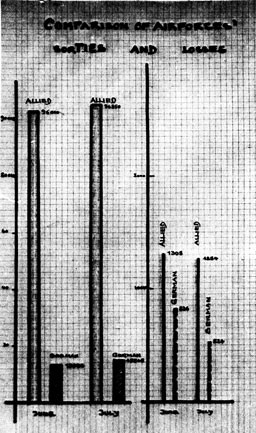
Appendix 4. - Daily Bomber Sorties LFL 3 against Ship and Land Targets
6.6-30.6.44.
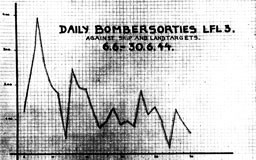
Appendix 5. - Daily Bomber Sorties LFL 3 against Ship and Land Targets
1.7-31.7.44.
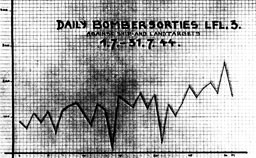
Appendix 6. - Fighter Sorties LFL. 3
June-July 1944.
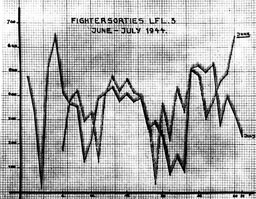
Appendix 7. - Daily Total of Sorties of All Kinds of Aircraft of LFL. 3
June-July 1944.
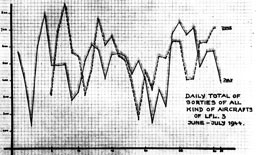
Appendix 8. - Minelaying by Aircraft LFL. 3
June-July 1944.
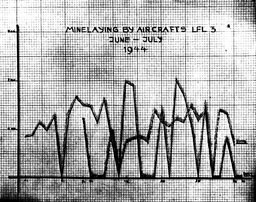
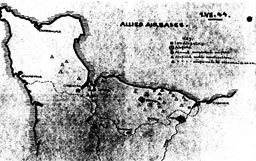
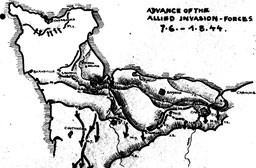
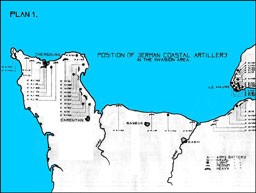
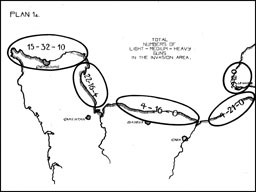
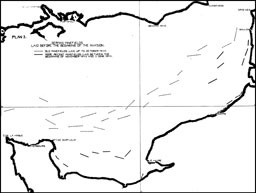
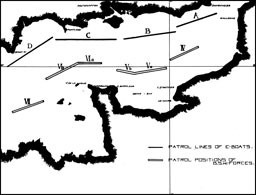
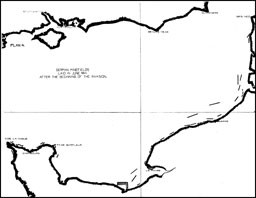
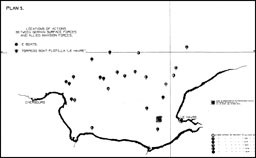
[END]



